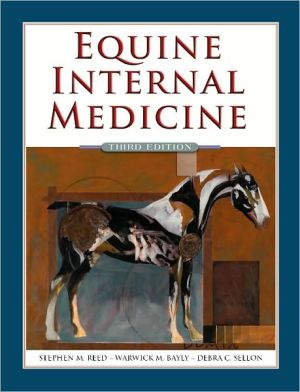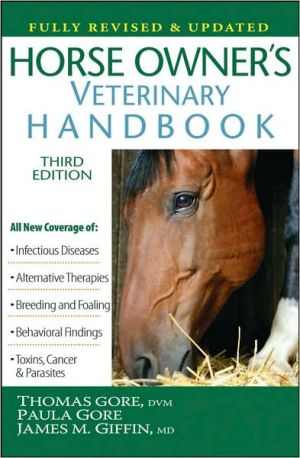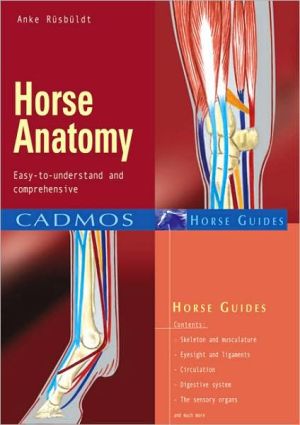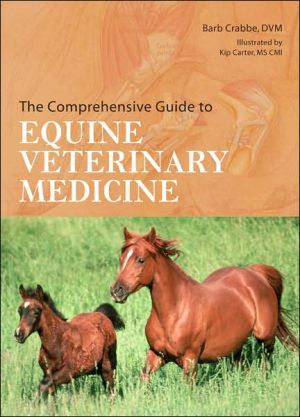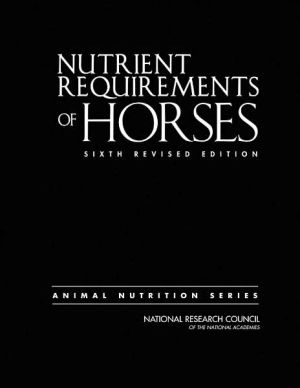Equine Internal Medicine
Develop an essential understanding of the principles of equine disease with this one-of-a-kind, problem-based resource! Extensively revised and updated with contributions from an international team of experts, Equine Internal Medicine, 3rd Edition reflects the latest clinical research in equine medicine and focuses on the basic pathophysiologic mechanisms that underlie the development of various equine diseases to help you confidently diagnose, treat, and manage patient conditions.\ •...
Search in google:
Develop an essential understanding of the principles of equine disease with this one-of-a-kind, problem-based resource! Extensively revised and updated with contributions from an international team of experts, Equine Internal Medicine, 3rd Edition reflects the latest clinical research in equine medicine and focuses on the basic pathophysiologic mechanisms that underlie the development of various equine diseases to help you confidently diagnose, treat, and manage patient conditions.• Problem-based approach outlines how to apply the latest clinical evidence directly to the conditions you’ll encounter in practice. • Pathophysiology is emphasized throughout, providing a sound basis for discussions of the diagnosis, treatment, and prognosis that follow. • Body systems chapters begin with a thorough discussion of the diagnostic method appropriate to the system, including physical examination, clinical pathology, radiography, endoscopy, and ultrasonography. • Flow charts, diagrams, and algorithms clarify complex material.• Extensive content updates help you improve patient care with up-to-date research and clinical evidence across the full spectrum of equine practice, including:• New sections on biofilm ahesins, resistance to phagocytosis, and host substrate utilization • New information on changes in body weight • Recent findings on fibrocoxib and diclofenac • Expanded and reorganized coverage of critical care • New material on inborn errors of metabolism and acquired myopathies • Detailed treatment information on various disorders of the reproductive tract • A new section on toxicoses causing signs related to liver disease or dysfunction • Bound-in companion DVD includes more than 120 high-quality video clips that guide you through procedures related to the cardiovascular and neurologic systems. David E. Freeman This book deals with equine internal medicine according to disease mechanisms and treatment principles in the first section and by specific body systems in the second. The purposes of this book are to provide a better understanding of medical disease processes that affect horses and to improve the ability of the veterinary profession to understand and treat these diseases. The demand for such a book is directly attributable to the level of sophistication the development of equine internal medicine has achieved today. By designing the book so that the first section is problem-based, the practitioner will then have a guideline to follow through the second part. The book satisfies its worthy objectives. This book will be valuable to the student, resident, practitioner, and specialist involved in equine medicine. This is a wider range than the editors intended for their audience, which included discerning members of the horse-owning public. That it would satisfy many of the latter is possible, but some chapters are aimed at specialists only. The editors and contributors have certainly done an outstanding job in achieving the goals of this book. The illustrations, pictures, and tables are of top quality and serve their purposes well. Some endoscopic images, although of top quality, could be improved by omission of identifying items (i.e., owner's names). References are current and pertinent, and the table of contents and index are both very helpful. The book is well organized and has a very pleasant appearance. As exemplified by the chapter on gastroduodenal ulceration, the book provides information that is not available elsewhere. This book is a must for any veterinary library,private practice, bookstore, and for anyone involved in equine medicine at any level. The editors and contributors are leaders in their fields, so this book contains highly credible, new information. Faults are few and minor, such as the absence of colic and diarrhea in Chapter 3 as separate topics. Also Table 13-1, by inclusion of items that do not apply to horses, or without modification to make it applicable to horses, mars an otherwise excellent chapter. Overall, the book is very readable. The editors' goals have been satisfied and this single volume includes more material of value to its audience than many other texts combined.
Pt. I Mechanisms of Disease and Principles of Treatment1 The Equine Immune System 12 Mechanisms of Infectious Disease 573 Clinical Approach to Commonly Encountered Problems 914 Pharmacologic Principles 1485 Aspects of Clinical Nutrition 2056 Recognizing and Treating Pain in Horses 2337 Critical Care 2468 Epidemiology 280Pt. II Disorders of Specific Body Systems9 Disorders of the Respiratory System 29010 Cardiovascular Diseases 37211 Disorders of the Musculoskeletal System 48812 Disorders of the Neurologic System 54513 Disorders of the Skin 68214 Disorders of the Hematopoietic System 73015 Disorders of the Gastrointestinal System 77716 Disorders of the Liver 93917 Equine Ophthalmology 97618 Disorders of the Reproductive Tract 100419 Disorders of the Urinary System 114020 Disorders of the Endocrine System 124821 Disorders of Foals 131122 Toxicologic Problems 1364
\ From the Publisher"The authors have successfully brought explanations of the mechanisms behind complicated disease, with clinical tests and laboratory findings onto treatment options, all under one roof, in a way which enables it to be referenced quickly, and easily but to provide an in-depth source of reference which invariably leaves the reader feeling much more knowledgeable about a specific topic after reading the appropriate chapter. The detail of the text is very effectively reinforced by tables and diagrams which summarised the information and so the student of inexperienced clinician need not be intimidated to reach in and to delve for more information"\ Equine Veterinary Journal, August 2010\ \ \ \ \ \ David E. FreemanThis book deals with equine internal medicine according to disease mechanisms and treatment principles in the first section and by specific body systems in the second. The purposes of this book are to provide a better understanding of medical disease processes that affect horses and to improve the ability of the veterinary profession to understand and treat these diseases. The demand for such a book is directly attributable to the level of sophistication the development of equine internal medicine has achieved today. By designing the book so that the first section is problem-based, the practitioner will then have a guideline to follow through the second part. The book satisfies its worthy objectives. This book will be valuable to the student, resident, practitioner, and specialist involved in equine medicine. This is a wider range than the editors intended for their audience, which included discerning members of the horse-owning public. That it would satisfy many of the latter is possible, but some chapters are aimed at specialists only. The editors and contributors have certainly done an outstanding job in achieving the goals of this book. The illustrations, pictures, and tables are of top quality and serve their purposes well. Some endoscopic images, although of top quality, could be improved by omission of identifying items (i.e., owner's names). References are current and pertinent, and the table of contents and index are both very helpful. The book is well organized and has a very pleasant appearance. As exemplified by the chapter on gastroduodenal ulceration, the book provides information that is not available elsewhere. This book is a must for any veterinary library,private practice, bookstore, and for anyone involved in equine medicine at any level. The editors and contributors are leaders in their fields, so this book contains highly credible, new information. Faults are few and minor, such as the absence of colic and diarrhea in Chapter 3 as separate topics. Also Table 13-1, by inclusion of items that do not apply to horses, or without modification to make it applicable to horses, mars an otherwise excellent chapter. Overall, the book is very readable. The editors' goals have been satisfied and this single volume includes more material of value to its audience than many other texts combined.\ \ \ From The CriticsReviewer: David E. Freeman, MVB, PhD(University of Illinois College of Veterinary Medicine)\ Description: This book deals with equine internal medicine according to disease mechanisms and treatment principles in the first section and by specific body systems in the second.\ Purpose: The purposes of this book are to provide a better understanding of medical disease processes that affect horses and to improve the ability of the veterinary profession to understand and treat these diseases. The demand for such a book is directly attributable to the level of sophistication the development of equine internal medicine has achieved today. By designing the book so that the first section is problem-based, the practitioner will then have a guideline to follow through the second part. The book satisfies its worthy objectives.\ Audience: This book will be valuable to the student, resident, practitioner, and specialist involved in equine medicine. This is a wider range than the editors intended for their audience, which included discerning members of the horse-owning public. That it would satisfy many of the latter is possible, but some chapters are aimed at specialists only. The editors and contributors have certainly done an outstanding job in achieving the goals of this book.\ Features: The illustrations, pictures, and tables are of top quality and serve their purposes well. Some endoscopic images, although of top quality, could be improved by omission of identifying items (i.e., owner's names). References are current and pertinent, and the table of contents and index are both very helpful. The book is well organized and has a very pleasant appearance. As exemplified by the chapter on gastroduodenal ulceration, the book provides information that is not available elsewhere.\ Assessment: This book is a must for any veterinary library, private practice, bookstore, and for anyone involved in equine medicine at any level. The editors and contributors are leaders in their fields, so this book contains highly credible, new information. Faults are few and minor, such as the absence of colic and diarrhea in Chapter 3 as separate topics. Also Table 13-1, by inclusion of items that do not apply to horses, or without modification to make it applicable to horses, mars an otherwise excellent chapter. Overall, the book is very readable. The editors' goals have been satisfied and this single volume includes more material of value to its audience than many other texts combined.\ \ \ \ \ 4 Stars! from Doody\ \
